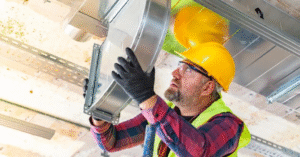5 Roof Care Mistakes That Can Shorten Your Roof’s Lifespan
Roof Maintenance Myths That Could Cost You: What Melbourne Roofers Want You to Know
If you own a home, your roof is one of the most important things protecting it, but for most of us, it’s also one of the things we pay the least amount of attention to. We notice at once a dripping faucet, but a sneaky roof problem can creep along for years before showing its face.
Ask any experienced Melbourne roofer and they’ll confirm the same: third of the expensive roof repairs they’re dealing with could have been avoided if the owner had identified minor issues earlier.
Unfortunately, there is plenty of “dodgy wisdom” to go around on how to keep a roof. Let’s thus analyze the most common roof maintenance mistakes that would cut short the years of your roof’s lifespan and how you can steer clear of them.

1. Thinking a Clean Roof Is Always a Healthy Roof
Most assume that if a roof looks clean from the ground, it’s fine. The truth? Some of the biggest roof problems aren’t visible until you approach a little closer.
Under all that sheeting or tiles, there may be loose nails, broken sealants, or rust spots forming out of sight. And on your roof, where there are valleys (the V-shaped gutters where two roof slopes meet), leaves will collect there even if the surface looks otherwise clean.
In Melbourne’s leafy eastern suburbs, it’s not at all uncommon for houses to be surrounded by gum trees that shed leaves and bark that clog roof gutters. The roof might look pristine from your driveway, but in the gutters, it’s a tiny compost bin.
What to do instead:
Don’t judge your roof by appearance alone. Schedule a professional inspection every couple of years, and if you’re confident and safe on a ladder, check for hidden build-ups in valleys and gutters yourself.
2. Believing Your Roof Will “Last Forever”
Roofs are tough, but they’re not immortal. Each type of roof has a planned lifespan, and it will depend on weather, location, and the care you give it.
Concrete tiles can last 50 years, but only if they’re properly maintained. Metal roofs typically last 30–45 years before they need serious maintenance. But hailstorms, heavy winds, and even wildlife (hi, possums!) can accelerate wear and tear.
Houses in Melbourne’s bayside suburbs, for instance, are subjected to salt-laden air that corrodes metal at a quicker rate. A house at Box Hill may have the same roofing material, but without the exposure to salt, it’ll tend to last longer.
What to do instead:
Know the age and material of your roof, and plan ahead for maintenance or replacement. Treat it like a car, you don’t wait for the engine to fail before changing the oil.
3. Thinking Gutter Cleaning Is Optional
If you’ve ever told yourself, “I’ll get to the gutters next summer,” you’re not alone. But neglecting gutters is one of the fastest ways to shorten your roof’s lifespan.
Clogged gutters not only overflow, but force water back behind the roofline, causing rotting fascia boards, waterlogged insulation, and occasionally water leaking into your walls.
Inner-city Melbourne roofers commonly encounter heritage terraces with their original timber fascias reduced to rubble by years of gutter abandonment. Replacing these not only is costly, it may involve council permission for heritage approval.
What to do instead:
Clean your gutters at least twice a year, especially after autumn. If you live under trees, make it quarterly. Consider gutter guards if blockages are constant.
4. Relying on DIY Fixes for Major Problems
DIY may be wonderful for some home jobs. Painting a wall? Fine. Changing a tap washer? Do it. Patching large roof leaks with store-bought sealant? Asking for trouble.
A quick patch might stop water for a week, but it often traps moisture inside, rotting the roof structure beneath. We’ve seen cases where a small $200 repair ballooned into a $6,000 rebuild because the homeowner “fixed” it themselves without addressing the underlying cause.
In suburbs such as Carlton or Fitzroy, where the older houses have intricate rooflines, even the determination of the actual location of a leak can be difficult, water can travel metres from the real hole before dripping in.
What to do instead:
Handle basic maintenance yourself, but leave major roof repairs to someone trained. Even if you think you’ve found the problem, it’s worth getting a second set of eyes on it.
5. Ignoring the Small Warning Signs
Your roof rarely fails without warning. The signs are there, we just tend to ignore them.
Things like:
- A single cracked tile
- Flaking paint on metal roofing
- Water stains on a ceiling after heavy rain
- Sagging gutter sections
- Moss or lichen growing in shaded spots
A Melbourne roofer once told me about a client in Richmond who spotted a small brown mark on their ceiling but ignored it for years. By the time they acted, the slow leak had rotted out half the ceiling joists. The repair bill? Eye-watering.
What to do instead:
Treat small roof issues like you would a toothache, early action saves pain (and money) later. Keep an eye out after storms, especially in suburbs prone to high winds.
Bonus: How Roof Care Differs Around Melbourne
Roof care isn’t a one-size-fits-all job — the challenges differ from suburb to suburb:
- Bayside suburbs (e.g., Brighton, Sandringham): Salt corrosion is a big enemy of metal roofs. Regular washing helps slow it down.
- Leafy suburbs (e.g., Kew, Blackburn): Constant leaf litter means more gutter cleaning and valley clearing.
- Inner-city terraces (e.g., Fitzroy, Carlton): Often have older roofing materials and tricky access, making maintenance more complex.
- Outer growth areas (e.g., Werribee, Craigieburn): New builds may have modern materials but still need early inspections to catch builder faults.
Final Thoughts
Your roof’s not merely “up there” keeping the rain out, it’s a living component of your home’s defense system. It requires attention, maintenance, and the occasional professional tune-up.
Steering clear of these five errors, including presuming a clean roof is adequate, believing it will last forever, neglecting gutter cleaning, fixing leakages yourself, and ignoring signs of trouble, can extend its lifespan by years.
A little preventative care now will always be cheaper than a full roof replacement later. And as any experienced Melbourne roofer will tell you, the best roof repairs are the ones you never had to make in the first place.










Post Comment